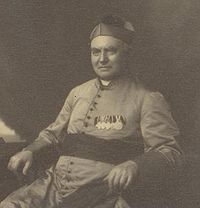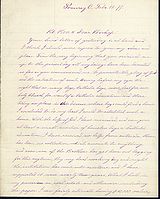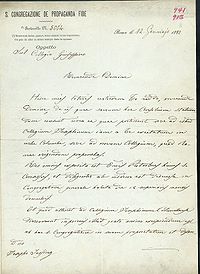
Joseph Jessing
Encyclopedia

Orphanage
An orphanage is a residential institution devoted to the care of orphans – children whose parents are deceased or otherwise unable or unwilling to care for them...
work and Catholic education. He was also the founder of the Pontifical College Josephinum
Pontifical College Josephinum
The Pontifical College Josephinum is a four-year, Roman Catholic liberal arts college and graduate school of theology founded by Monsignor Joseph Jessing in 1888 and located in Columbus, Ohio, USA. The seminary prepares its students to become priests in the Roman Catholic Church. Students come...
in Columbus, Ohio
Columbus, Ohio
Columbus is the capital of and the largest city in the U.S. state of Ohio. The broader metropolitan area encompasses several counties and is the third largest in Ohio behind those of Cleveland and Cincinnati. Columbus is the third largest city in the American Midwest, and the fifteenth largest city...
, in 1888.
Birth and Childhood
In the early 19th century, a young German named John William Jessing married Anna Maria Schlusemann of StadtlohnStadtlohn
Stadtlohn is a town in the north-west of North Rhine-Westphalia, Germany, part of the district Borken. The Berkel river flows through it on its way to the Netherlands.-Division of the town:Stadtlohn consists of 9 districts:* Almsick* Büren* Estern...
near the Dutch
Netherlands
The Netherlands is a constituent country of the Kingdom of the Netherlands, located mainly in North-West Europe and with several islands in the Caribbean. Mainland Netherlands borders the North Sea to the north and west, Belgium to the south, and Germany to the east, and shares maritime borders...
boundary. Anna was John's second wife. She was the daughter of Engelbert Schlusemann, a shoemaker, the trade in which her husband also was engaged. Three children were born of this union. Among them was John Joseph, born at No. 4 Kleiboltengasse in Muenster, Germany on (November 17, 1836). A daughter, Wilhelmina Frances lived (December 31, 1839 - September 4, 1940) and a posthumous son, Bernard Anthony William lived (August 12, 1841 through May 1869. In 1840, Joseph's father, John William, died leaving a very young family.

Early years and Prussian military service
As a boy, Jessing worked in a print shopPrint shop
Print shop may refer to:* Printer , someone providing commercial printing services* The Print Shop, a desktop publishing software...
to provide for his mother and two siblings as his father had died when Jessing was only four years old. The young boy devoted what little spare time he had to reading and study. When he grew to manhood, Jessing did what many young boys did when he enlisted in the Prussia
Prussia
Prussia was a German kingdom and historic state originating out of the Duchy of Prussia and the Margraviate of Brandenburg. For centuries, the House of Hohenzollern ruled Prussia, successfully expanding its size by way of an unusually well-organized and effective army. Prussia shaped the history...
n army, an organization known for its severe training regimen and discipline.
In the army, Jessing rose to the rank of quartermaster
Quartermaster
Quartermaster refers to two different military occupations depending on if the assigned unit is land based or naval.In land armies, especially US units, it is a term referring to either an individual soldier or a unit who specializes in distributing supplies and provisions to troops. The senior...
sergeant, who proved himself a successful fighter as well as logistician. He was decorated by Kaiser William I
William I, German Emperor
William I, also known as Wilhelm I , of the House of Hohenzollern was the King of Prussia and the first German Emperor .Under the leadership of William and his Chancellor Otto von Bismarck, Prussia achieved the unification of Germany and the...
of Prussia
Prussia
Prussia was a German kingdom and historic state originating out of the Duchy of Prussia and the Margraviate of Brandenburg. For centuries, the House of Hohenzollern ruled Prussia, successfully expanding its size by way of an unusually well-organized and effective army. Prussia shaped the history...
for bravery at the Battle of Dybbøl
Battle of Dybbøl
The Battle of Dybbøl was the key battle of the Second War of Schleswig and occurred on the morning of 18 April 1864 following a siege lasting from 7 April. Denmark suffered a severe defeat against the German Confederation which decided the war...
, earning many decorations and medals for his service in the Seventh Westphalian
Westphalian
Westphalian may refer to:* The culture or people of the Westphalia region of Germany* Westphalian language, one of the major dialect groups of West Low German* Westphalian sovereignty, a concept in international relations* Westphalian , in geology...
Artillery
Artillery
Originally applied to any group of infantry primarily armed with projectile weapons, artillery has over time become limited in meaning to refer only to those engines of war that operate by projection of munitions far beyond the range of effect of personal weapons...
during both the First
First War of Schleswig
The First Schleswig War or Three Years' War was the first round of military conflict in southern Denmark and northern Germany rooted in the Schleswig-Holstein Question, contesting the issue of who should control the Duchies of Schleswig and Holstein. The war, which lasted from 1848–1851,...
and the Second
Second War of Schleswig
The Second Schleswig War was the second military conflict as a result of the Schleswig-Holstein Question. It began on 1 February 1864, when Prussian forces crossed the border into Schleswig.Denmark fought Prussia and Austria...
wars with Denmark
Denmark
Denmark is a Scandinavian country in Northern Europe. The countries of Denmark and Greenland, as well as the Faroe Islands, constitute the Kingdom of Denmark . It is the southernmost of the Nordic countries, southwest of Sweden and south of Norway, and bordered to the south by Germany. Denmark...
over the Schleswig-Holstein Question
Schleswig-Holstein Question
The Schleswig-Holstein Question was a complex of diplomatic and other issues arising in the 19th century from the relations of two duchies, Schleswig and Holstein , to the Danish crown and to the German Confederation....
. Despite all these military achievements, Joseph's dream of ordination
Holy Orders
The term Holy Orders is used by many Christian churches to refer to ordination or to those individuals ordained for a special role or ministry....
remained his true ambition.
In 1867, Jessing left his home in Münster
Münster
Münster is an independent city in North Rhine-Westphalia, Germany. It is located in the northern part of the state and is considered to be the cultural centre of the Westphalia region. It is also capital of the local government region Münsterland...
, Westphalia
Westphalia
Westphalia is a region in Germany, centred on the cities of Arnsberg, Bielefeld, Dortmund, Minden and Münster.Westphalia is roughly the region between the rivers Rhine and Weser, located north and south of the Ruhr River. No exact definition of borders can be given, because the name "Westphalia"...
, to pursue his lifelong vocation of the Roman Catholic priesthood. Unbeknownst to Jessing, this was the first step of the many steps he would take toward the founding of an orphanage, a college and a seminary in the United States.
Immigration to the US and ordination
In 1867, young Joseph emigrated to the United States and began his studies at Mount Saint Mary's Seminary of the WestAthenaeum of Ohio
The Athenaeum of Ohio – Mount St. Mary's Seminary of the West, originally St. Francis Xavier Seminary, is the third-oldest Roman Catholic seminary in the United States and is currently located at 6616 Beechmont Avenue in the Cincinnati, Ohio neighborhood of Mt. Washington, in the former Saint...
in Cincinnati, Ohio
Ohio
Ohio is a Midwestern state in the United States. The 34th largest state by area in the U.S.,it is the 7th‑most populous with over 11.5 million residents, containing several major American cities and seven metropolitan areas with populations of 500,000 or more.The state's capital is Columbus...
, in 1868, to serve in the newly-founded Diocese of Columbus. He was ordained a priest by its first bishop
Bishop
A bishop is an ordained or consecrated member of the Christian clergy who is generally entrusted with a position of authority and oversight. Within the Catholic Church, Eastern Orthodox, Oriental Orthodox Churches, in the Assyrian Church of the East, in the Independent Catholic Churches, and in the...
, the Right Reverend
Right Reverend
The Right Reverend is a style applied to certain religious figures.*In the Anglican Communion and the Roman Catholic Church in Great Britain it applies to bishops except that The Most Reverend is used for archbishops .*In some churches with a...
Sylvester Rosecrans, at St. Patrick Pro-Cathedral
St. Joseph Cathedral, Columbus
St. Joseph Cathedral is a Catholic cathedral located in Columbus, Ohio, United States. It is the seat of the Diocese of Columbus. -History:...
in Columbus on July 16, 1870, and was assigned to Sacred Heart Church in Pomeroy, Ohio
Pomeroy, Ohio
Pomeroy is a village in and the county seat of Meigs County, Ohio, United States, along the Ohio River. The population was 1,966 at the 2000 census. During the late 19th century, Pomeroy was an important producer of coal and salt...
.

Founding a German-language newspaper, and boys orphanage
Soon after arriving at Sacred Heart, Jessing became deeply concerned about the orphan boys in his parish. With the assistance of the Poor Brothers of Saint Francis, he provided these needy children with shelter, food, and schooling. This work led to his establishing the Saint Joseph Orphan Asylum. The orphanage was funded primarily through Jessing's German-language newspaper, "The Ohio" (later called "Ohio Waisenfreund", meaning "Ohio Orphan's Friend"), with Jessing as chief writer and publisher. Jessing used the proceeds from the small newspaper to fund his work with the orphans so that it would be self-sustaining.Operation relocates to Columbus Ohio
In 1877, Father Jessing wrote a letter to Bishop Rosecrans asking permission to bring his newspaper and the orphan's asylum to a larger city. In that letter, he explained that he needed to be closer to the railroad in order to distribute his paper. Since he wanted the work to be self-sustaining, he also discussed an industrial school that he wanted to start in connection with the orphan's asylum where boys could learn a trade to support themselves as adults.Rosecrans approved Jessing's plan, and the newspaper and orphan's asylum were moved to Columbus later that year and was closer to the railroad. Besides the industrial school, Father Jessing started various trade opportunities for the orphans including the Josephinum Church Furniture Company where the boys could be taught a trade.
Founding of Collegium Josephinum seminary
When four older boys expressed a desire to study for the priesthood, Jessing advertised in his paper that he would sponsor two boys who wished to become priests but who lacked the financial means to do so. Of the forty applicants, Jessing accepted twenty-three and the first academic classes began on September 1, 1888. In memory of the original St. Joseph's Orphanage, this seminary was called, in LatinLatin
Latin is an Italic language originally spoken in Latium and Ancient Rome. It, along with most European languages, is a descendant of the ancient Proto-Indo-European language. Although it is considered a dead language, a number of scholars and members of the Christian clergy speak it fluently, and...
, the Collegium Josephinum or Josephinum College.
As those first students progressed through the seminary program, the institution initially provided six years of primary education ("minor seminary," four years of high school and two years of college) and six years of secondary seminary education ("major seminary," another two years of college/pre-theology and four years of theology/ seminary).

The seminary becomes the Pontifical College Josephinum
To ensure that the Josephinum would continue after his death, Jessing asked that the fledgling institution be placed under the protection of the Holy SeeHoly See
The Holy See is the episcopal jurisdiction of the Catholic Church in Rome, in which its Bishop is commonly known as the Pope. It is the preeminent episcopal see of the Catholic Church, forming the central government of the Church. As such, diplomatically, and in other spheres the Holy See acts and...
. Pope Leo XIII
Pope Leo XIII
Pope Leo XIII , born Vincenzo Gioacchino Raffaele Luigi Pecci to an Italian comital family, was the 256th Pope of the Roman Catholic Church, reigning from 1878 to 1903...
granted the request in 1892, thus making the Josephinum the first Pontifical University
Pontifical university
A pontifical university is a Catholic University established by and directly under the authority of the Holy See. It is licensed to grant academic degrees in sacred faculties, the most important of which are Sacred Theology, Canon Law, Sacred Scripture and...
outside of Italy
Italy
Italy , officially the Italian Republic languages]] under the European Charter for Regional or Minority Languages. In each of these, Italy's official name is as follows:;;;;;;;;), is a unitary parliamentary republic in South-Central Europe. To the north it borders France, Switzerland, Austria and...
. From that time to the present, the institution has been under the direction of the Congregation for Seminaries, with the Apostolic Nuncio to the United States as its Chancellor
Chancellor
Chancellor is the title of various official positions in the governments of many nations. The original chancellors were the Cancellarii of Roman courts of justice—ushers who sat at the cancelli or lattice work screens of a basilica or law court, which separated the judge and counsel from the...
. The Josephinum was incorporated under the laws of the State of Ohio in 1894. The seminary is financially independent from both the Holy See and the Diocese of Columbus.
In June 1896, Pope Leo named Jessing to the title of Domestic Prelate to honor him for his years of service to the Church and the community. Due to this, he was now referred to as Monsignor
Monsignor
Monsignor, pl. monsignori, is the form of address for those members of the clergy of the Catholic Church holding certain ecclesiastical honorific titles. Monsignor is the apocopic form of the Italian monsignore, from the French mon seigneur, meaning "my lord"...
Jessing.
The first six seminarians to graduate the program were ordained to the priesthood in June 1899. Monsignor
Monsignor
Monsignor, pl. monsignori, is the form of address for those members of the clergy of the Catholic Church holding certain ecclesiastical honorific titles. Monsignor is the apocopic form of the Italian monsignore, from the French mon seigneur, meaning "my lord"...
Jessing was able to witness this before his death a few months later, on November 2nd of that year.
Relocation to Worthington Ohio and going forward
In 1931, Father Jessing's seminary, the Josephinum, moved to its present location in Worthington, OhioWorthington, Ohio
-Dissolution of the Company:By August 11, 1804 the plat maps were completed, payments or notes promising payments collected and deeds prepared for all sixteen thousand acres of the Scioto Company's purchase...
, eleven miles (18 km) north of Columbus on a landmark 100 acre (0.404686 km²) campus. The academic structure changed over time during the 1940s and 1950s from the "six-six" format to four years of high school, four years of college, and four years of theology/seminary (though the distinctions were gradual and unclear). The first official College commencement occurred in June 1953; the College and Recreation buildings were dedicated in 1958; and the high school closed in 1967.
The school's Constitution was first approved by Pope Pius XI in 1938 and was most recently revised and approved by the Congregation for Catholic Education
Congregation for Catholic Education
The Congregation for Catholic Education is the Pontifical congregation of the Roman Curia responsible for: seminaries and houses of formation of...
in 1996.
Since 1899, when six of the original twenty-three students were ordained, more than fifteen hundred priests have received their education at the Pontifical College Josephinum. More than three hundred and fifty graduates of the College of Liberal Arts have completed their studies for ordination at other theologates.
For the first few decades of its existence, the Josephinum focused its efforts on educating priests to work with the large population of German immigrants in the United States. After World War I, that focus shifted to preparing priests for dioceses that lack their own seminary. In recent years, the Josephinum has been blessed with a number of candidates from Eastern Europe, Asia, and Africa who come to the seminary to be educated for service in their native lands.
Since 1899, when those six of the original twenty-three students were ordained, more than fifteen hundred priests have received their education at the Pontifical College Josephinum; more than three hundred and fifty graduates of the College of Liberal Arts have completed their studies for ordination at other theologates. In 1966 the graduates of the seminary erected a plaque in his home city of Münster to honor Jessing.
Father Jessing, tough Prussian soldier, young immigrant, tireless advocate of orphans and founder of the only Pontifical College in North America had gone a long way on his journey from the Old World to the New. He was an American pioneer, but in a far different sense than that term is usually understood. As the old hymn
Onward, Christian Soldiers
"Onward, Christian Soldiers" is a 19th century English hymn. The words were written by Sabine Baring-Gould in 1865, and the music was composed by Arthur Sullivan in 1871. Sullivan named the tune "St. Gertrude," after the wife of his friend Ernest Clay Ker Seymer, at whose country home he composed...
goes "Onward Christian Soldiers, marching off to war, with the Cross of Jesus going on before."
Works
Msgr. Jessing edited and published the "Ohio Waisenfreund", German for "Ohio Orphan's Friend"External links
- http://www.pcj.edu/aboutus/history.html Historical Sketch of Msgr. Joseph Jessing
- http://worlddmc.ohiolink.edu/OMP/NewSearch?results=10&fieldname=collection&sort=title&searchstatus=1&hits=10&searchmark=1&searchstring=Monsignor+John+Joseph+Jessing+Collection&format=list&searchtype=exact&count=1 OhioLink Digital Research Center
- http://www.ohiomemory.org/cdm4/item_viewer.php?CISOROOT=%2Fp267401coll36&CISOPTR=11682&DMSCALE=18.75000&DMWIDTH=600&DMHEIGHT=600&DMMODE=viewer&DMFULL=0&DMOLDSCALE=3.81098&DMX=0&DMY=0&DMTEXT=%25201877&DMTHUMB=1&REC=4&DMROTATE=0&x=76&y=77 Jessing and some of the orphans he helped in Ohio.

